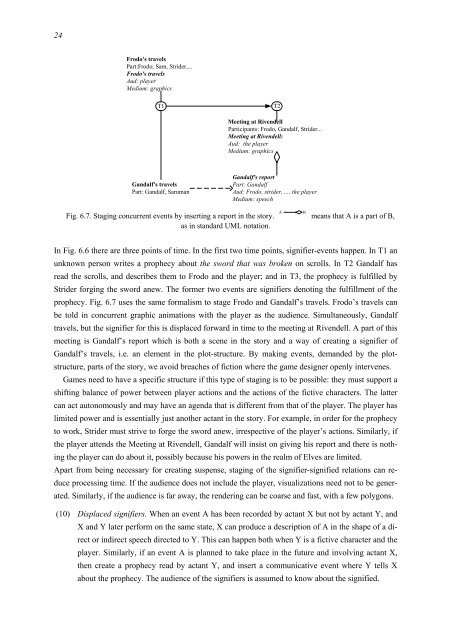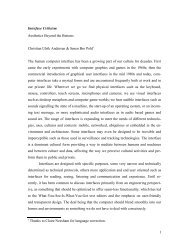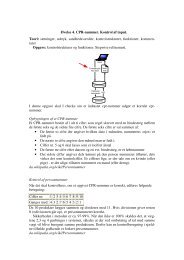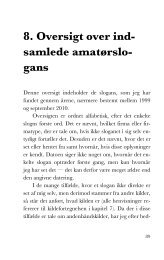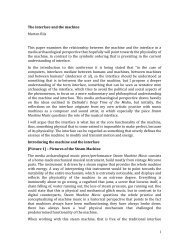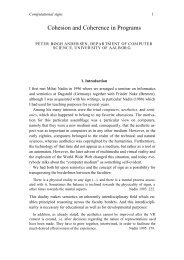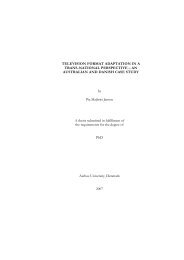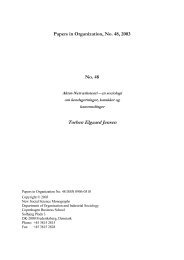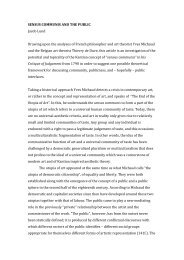Interaction and narration. Tearing Tolkien apart - CiteSeerX
Interaction and narration. Tearing Tolkien apart - CiteSeerX
Interaction and narration. Tearing Tolkien apart - CiteSeerX
You also want an ePaper? Increase the reach of your titles
YUMPU automatically turns print PDFs into web optimized ePapers that Google loves.
24<br />
Frodo's travels<br />
Part:Frodo, Sam, Strider,...<br />
Frodo's travels<br />
Aud: player<br />
Medium: graphics<br />
T1<br />
T2<br />
Meeting at Rivendell<br />
Participants: Frodo, G<strong>and</strong>alf, Strider...<br />
Meeting at Rivendell:<br />
Aud: the player<br />
Medium: graphics<br />
G<strong>and</strong>alf's travels<br />
Part: G<strong>and</strong>alf, Saruman<br />
G<strong>and</strong>alf's report<br />
Part: G<strong>and</strong>alf<br />
Aud: Frodo, strider, ..., the player<br />
Medium: speech<br />
Fig. 6.7. Staging concurrent events by inserting a report in the story. A B means that A is a part of B,<br />
as in st<strong>and</strong>ard UML notation.<br />
In Fig. 6.6 there are three points of time. In the first two time points, signifier-events happen. In T1 an<br />
unknown person writes a prophecy about the sword that was broken on scrolls. In T2 G<strong>and</strong>alf has<br />
read the scrolls, <strong>and</strong> describes them to Frodo <strong>and</strong> the player; <strong>and</strong> in T3, the prophecy is fulfilled by<br />
Strider forging the sword anew. The former two events are signifiers denoting the fulfillment of the<br />
prophecy. Fig. 6.7 uses the same formalism to stage Frodo <strong>and</strong> G<strong>and</strong>alf’s travels. Frodo’s travels can<br />
be told in concurrent graphic animations with the player as the audience. Simultaneously, G<strong>and</strong>alf<br />
travels, but the signifier for this is displaced forward in time to the meeting at Rivendell. A part of this<br />
meeting is G<strong>and</strong>alf’s report which is both a scene in the story <strong>and</strong> a way of creating a signifier of<br />
G<strong>and</strong>alf’s travels, i.e. an element in the plot-structure. By making events, dem<strong>and</strong>ed by the plotstructure,<br />
parts of the story, we avoid breaches of fiction where the game designer openly intervenes.<br />
Games need to have a specific structure if this type of staging is to be possible: they must support a<br />
shifting balance of power between player actions <strong>and</strong> the actions of the fictive characters. The latter<br />
can act autonomously <strong>and</strong> may have an agenda that is different from that of the player. The player has<br />
limited power <strong>and</strong> is essentially just another actant in the story. For example, in order for the prophecy<br />
to work, Strider must strive to forge the sword anew, irrespective of the player’s actions. Similarly, if<br />
the player attends the Meeting at Rivendell, G<strong>and</strong>alf will insist on giving his report <strong>and</strong> there is nothing<br />
the player can do about it, possibly because his powers in the realm of Elves are limited.<br />
Apart from being necessary for creating suspense, staging of the signifier-signified relations can reduce<br />
processing time. If the audience does not include the player, visualizations need not to be generated.<br />
Similarly, if the audience is far away, the rendering can be coarse <strong>and</strong> fast, with a few polygons.<br />
(10) Displaced signifiers. When an event A has been recorded by actant X but not by actant Y, <strong>and</strong><br />
X <strong>and</strong> Y later perform on the same state, X can produce a description of A in the shape of a direct<br />
or indirect speech directed to Y. This can happen both when Y is a fictive character <strong>and</strong> the<br />
player. Similarly, if an event A is planned to take place in the future <strong>and</strong> involving actant X,<br />
then create a prophecy read by actant Y, <strong>and</strong> insert a communicative event where Y tells X<br />
about the prophecy. The audience of the signifiers is assumed to know about the signified.


